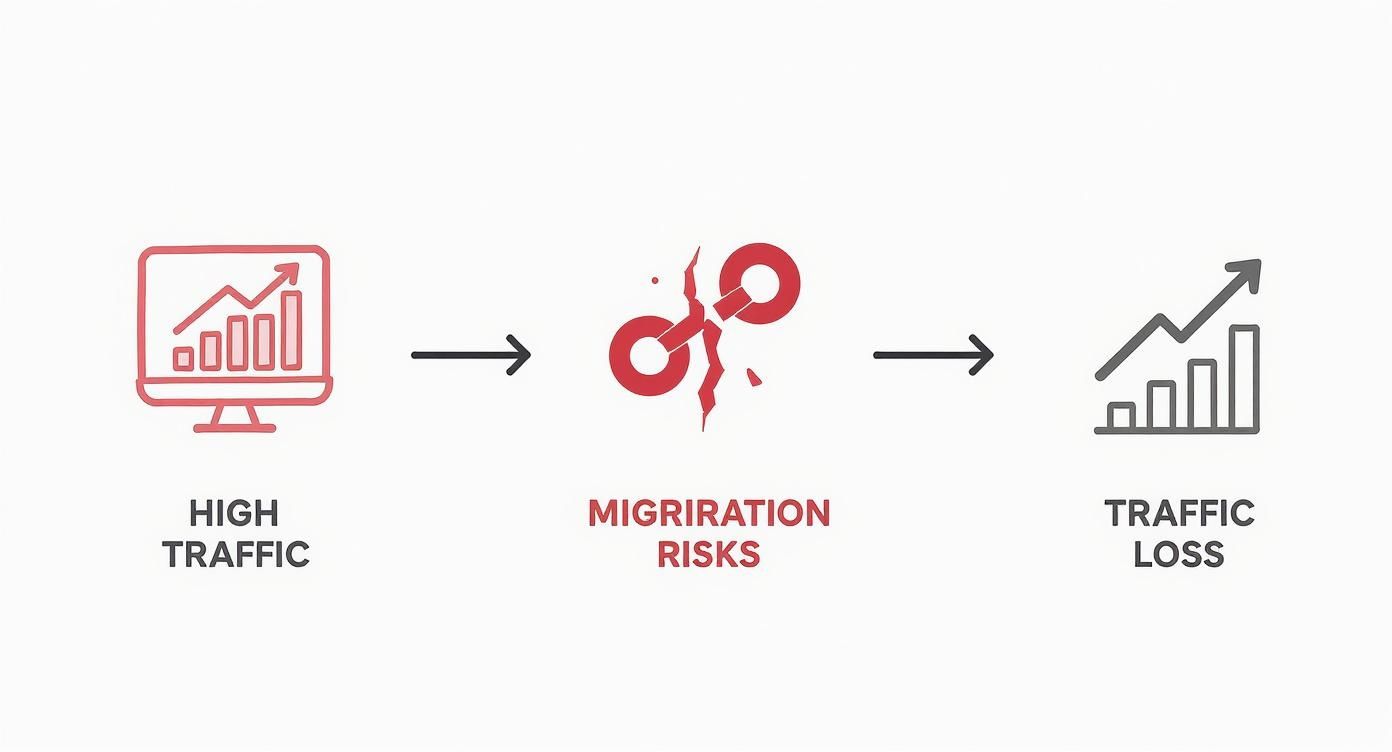Website migration SEO is all about moving your website without losing your hard-earned search engine rankings, traffic, and visibility. The goal is simple: tell search engines your site has a new address and make sure all the authority and value from your old pages get passed over to the new ones.
The Real Risks of Website Migration SEO
Moving your website isn't just a simple tech update—it's one of the most dangerous moments for your organic traffic and revenue. For any UK business, a migration gone wrong can wipe out years of SEO progress. That’s why having a solid website migration SEO strategy isn't just a good idea; it's essential for survival.
Often, migrations come from a good place. Maybe you’re rebranding, upgrading your e-commerce platform from Magento to Shopify, or switching from a .co.uk to a .com domain to go global. These are all moves designed for growth, but they introduce massive risks if you don't handle them with care.
Why Most Migrations Damage SEO
The real danger is breaking the connection between your content and the search engines that rank it. Google has spent years crawling, indexing, and getting to know your old URLs. When those URLs suddenly change without any guidance, all that built-up authority just disappears. The fallout can be swift and brutal.
A UK-focused analysis found that over 50% of websites see their organic traffic plummet by more than 50% right after a migration. Getting back on your feet is a slow, painful grind, with most sites taking around 18 months just to stabilise. Even worse, 17% of sites never recover the traffic they lost. You can find more details about these website migration findings over at Numentechnology.co.uk.
A website migration without an SEO-first approach is like moving house but forgetting to tell the post office, your bank, and all your friends your new address. You’ll become invisible, and valuable assets (in this case, traffic and customers) will get lost along the way.
The Cost of Getting It Wrong
The damage goes way beyond a temporary dip in your rankings. A botched migration can lead to some serious problems:
- Drastic Traffic Loss: Your most valuable pages can vanish from search results, cutting off your main source of leads and sales.
- Revenue Collapse: For e-commerce businesses, a drop in visibility is a direct hit to the bottom line, often costing thousands of pounds a day.
- Damaged Brand Authority: Nothing erodes trust like broken links and error pages. It creates a terrible user experience that can tarnish your brand's reputation.
- Lengthy Recovery: Fixing a failed migration is a nightmare. It's far more difficult and expensive than getting it right the first time and can feel a lot like recovering from a Google penalty as you scramble to regain lost ground.
The difference is night and day: a migration that protects its SEO secures its future, while one that ignores it risks a total collapse.
Building Your Pre-Migration Blueprint
Any website migration worth its salt is won or lost long before you hit the launch button. This first phase—the planning and discovery stage—is all about laying the groundwork to protect your hard-earned traffic and revenue.
Think of it as drawing up an architect's blueprint before pouring the foundation. If you skip this part, you’re almost guaranteed to face serious structural problems later on.
First things first, you need to know exactly what you’re working with. Before making any moves, it’s vital to get a clear picture of your current site's health. The best way to do that is to conduct a thorough SEO audit. This isn't just a box-ticking exercise; it’s a deep dive to find your most valuable assets.
You're looking for your top-performing pages, the keywords that bring in the best traffic, and the backlink profile that holds up your domain authority. These are the crown jewels of your SEO, and protecting them should be your number one priority.
Inventory Every Single URL
To protect your assets, you have to know they exist in the first place. That means you need to run a comprehensive crawl of your current website to create a complete inventory of every single URL. We're talking pages, images, PDFs—every indexable file.
Tools like Screaming Frog or Sitebulb are non-negotiable here. A full crawl gives you the raw data needed for the critical URL mapping stage that comes next. It’ll also dig up hidden problems like redirect chains, 404 errors, and orphan pages that really need to be cleaned up before you even think about migrating.
Key Takeaway: Every URL on your current site is a potential point of failure. A complete inventory ensures nothing gets left behind, preventing the loss of valuable pages and the backlinks pointing to them. Without a full list, you're migrating blind.
This process really highlights how a successful website depends on a solid foundation, which is just as true when you're starting from scratch. For a structured approach to a new project, our SEO checklist for a new website offers a complementary view on getting the fundamentals right from day one.
Define Success with Clear KPIs
How will you actually know if the migration was a success? You can't just go by gut feeling. You need to set clear Key Performance Indicators (KPIs) before you start. These will be your benchmarks for measuring success once you've gone live.
Your KPIs need to be specific, measurable, and tied directly to business goals. I'd recommend tracking these:
- Organic Traffic: Keep a close eye on overall sessions, users, and page views coming from organic search.
- Keyword Rankings: Track the positions of your most important commercial and informational keywords.
- Conversion Rate: Watch for any changes in goal completions, whether that’s sales, lead forms, or newsletter sign-ups.
- Indexed Pages: Use Google Search Console to make sure your new pages are being indexed correctly and old ones are dropping out.
- Crawl Errors: Monitor for any spikes in 404s or other server errors right after the launch.
The graphic below shows the direct link between a poorly handled migration and the potential loss of your valuable traffic.

As you can see, failing to manage the migration properly breaks the connection between your established traffic and your new site, causing a steep and often avoidable drop.
Establish Your Staging Environment and Timeline
Finally, your pre-migration blueprint needs a practical plan for testing and a solid timeline. A staging environment—basically an identical, non-public copy of your new website—is non-negotiable. This is your sandbox where you can test everything from redirects to the user experience without messing with your live site.
Picking your migration timeline is just as crucial. Don't launch during your busiest sales period or right before a bank holiday. Plan the go-live for a time when traffic is normally lower, like early in the week. This gives your team plenty of time to monitor performance and fix any immediate problems without causing a major headache for the business. This careful planning is the final piece of your pre-migration blueprint, setting you up for a smooth transition.
Executing the Technical SEO Heavy Lifting
Alright, you’ve done the planning. Now it’s time to get your hands dirty with the technical side of things. This is where precision is everything, because small slip-ups here can cause major headaches down the line. The mission is simple: make sure search engines not only understand your move but reward you for it.
The absolute heart of this operation is your URL mapping sheet. Don't think of it as just another spreadsheet. This is the master document that tells Google how to transfer every bit of SEO value from the old site to the new one. Every single important URL from your initial crawl needs to be on this list, matched one-to-one with its new home.

Mastering URL Mapping and Redirects
Think of your URL map as the instruction manual for your 301 redirects. A 301 redirect sends a permanent signal to browsers and search engines that a page has moved for good, passing most of its link equity along with it. Messing this up is, without a doubt, the number one reason migrations fail and traffic plummets.
For example, a blog post at your-old-site.co.uk/blog/top-seo-tips must be mapped directly to its new equivalent, like your-new-site.com/insights/top-seo-tips. It has to be logical. Don't take the lazy route and redirect everything to the new homepage. That's a terrible experience for users, and search engines will likely treat those as soft 404s, effectively wiping out your hard-earned link equity.
Once the map is finalised, those 301s need to be implemented on the server. This is where the real technical work starts, and there’s no room for error. If you’re feeling out of your depth, this is a good time to call in professional site migration services to ensure it’s done right.
Canonicalisation and Internal Link Updates
While you're setting up redirects, you also have to wrangle canonicalisation. The rel="canonical" tag is your way of telling search engines, "This is the master version of the page I want you to index." It’s your best defence against duplicate content issues, which can pop up if pages are accessible through multiple URLs (like those with tracking parameters).
After migrating, every canonical tag on the new site must point to the new URL structure. It's an easy step to forget, but doing so confuses search engines and can split your SEO authority between old and new pages.
At the same time, you need to hunt down and update all internal links across the new site. Any old, hardcoded links will create redirect chains, which slow things down and can slightly weaken link equity. Running a 'find and replace' on your database is usually the quickest way to fix this, making sure every link points straight to its new destination.
Pro Tip: Before you even think about launching, run a crawler like Screaming Frog on your staging site. It will sniff out any internal links still pointing to old URLs or hitting 404 errors. It’s so much easier to fix these things pre-launch than to chase them down afterwards.
Guiding Search Engines with Robots.txt and Sitemaps
Your robots.txt file is a powerful little file that tells search engine crawlers where they can and can’t go. During migration, you have to be absolutely sure the new site’s robots.txt isn't blocking anything important. One of the most common (and disastrous) mistakes is leaving a Disallow: / rule from the staging environment, which tells Google to ignore your entire new site.
As soon as you go live, you need a new XML sitemap. This file is a roadmap for search engines, listing all the important pages you want them to crawl. It should only contain the final, canonical URLs from your new site. Once it's ready, submit it through Google Search Console to give Google a nudge and speed up the discovery process.
This whole process is a fundamental part of any serious site health check. For a deeper dive into how these elements work together, check out this comprehensive technical SEO audit checklist.
Finally, don’t forget these last few technical checks:
- Hreflang Tags: If you operate in multiple countries or languages, make sure every hreflang tag is updated to use the new domain and URLs.
- SSL Certificate: Double-check that your SSL certificate is installed correctly on the new domain and that it forces a secure HTTPS connection across the board.
Carefully ticking off each of these technical SEO boxes is what makes the difference between a seamless migration and a traffic catastrophe.
Managing a Smooth Launch and Monitoring Performance
Launch day isn't the finish line; it’s the starting pistol. The hours and weeks that follow are where all your meticulous planning really pays off. This phase is all about nailing the go-live and then immediately switching into a period of intense vigilance to catch and fix any issues before they can hurt your SEO.

Before you even think about flipping the switch, a final, exhaustive check on the staging site is non-negotiable. This is your last chance to spot problems in a safe, controlled environment. I always recommend running one last crawl to hunt for any stray broken links, double-checking that all redirects are firing correctly, and verifying that your analytics and tracking codes are present and working as expected.
The Go-Live Checklist
Once you're confident the staging site is flawless, it's time for the main event. The launch itself involves a few critical steps that need to be handled with real precision.
- Reduce DNS TTL: A few hours before you plan to go live, lower the Time-To-Live (TTL) on your DNS records. This tells servers to check for updates more frequently, which speeds up how quickly your new IP address spreads across the web.
- Update DNS Settings: Point your domain’s A record to the new server's IP address. This is the technical moment of "going live."
- Remove Staging Blocks: Immediately get rid of any password protection or
noindextags on the new site that you were using during development. - Inform Google: If you've changed your domain, use the Change of Address tool in Google Search Console. This is a direct signal to Google that you've moved intentionally.
Even with a perfect plan, migrations in the UK that involve big structural or CMS changes are risky. From my experience and UK-focused case studies, these migrations typically need 2 to 4 weeks for things to settle down, with a full recovery of search impressions often taking around 6 to 8 weeks. It's important to set these realistic expectations with your team from the start.
Post-Launch Vigilance and Monitoring
As soon as the new site is live, your focus has to shift immediately to monitoring. Don't just assume everything is working. You need to be actively looking for problems using a combination of tools and just good old-fashioned manual checks. The first 72 hours are absolutely critical.
Your first port of call should always be Google Search Console. It gives you the most direct feedback from the search engine itself. Keep a very close eye on the Index Coverage report for any spikes in errors, like server errors (5xx) or pages not found (404s). These are red flags that need investigating right away.
Key Insight: Don't forget there's a data lag in tools like Google Search Console. You can't rely on them alone in those first few hours. Real-time tools and server log analysis are vital for catching immediate, critical failures that could be costing you traffic and revenue from minute one.
Being proactive here is everything. If you see a sudden jump in errors, our guide on how to fix index coverage errors in Search Console has actionable steps to help you diagnose and sort them out fast.
Tracking Performance and Spotting Anomalies
Beyond just hunting for errors, you need to be tracking your predefined KPIs to actually measure the migration's success. This is where your pre-migration benchmark data becomes invaluable for a proper before-and-after comparison.
What to Monitor Daily for the First Two Weeks:
- Server Logs: Get into your server logs and see how Googlebot is crawling the new site. Is it finding your new URLs? Is it respecting your
robots.txtfile? - Keyword Rankings: Use a rank tracking tool to watch your most valuable keywords. A little bit of fluctuation is normal, but a sharp, sustained drop could signal a serious problem with redirects or content.
- Organic Traffic: In Google Analytics, compare your post-launch organic traffic to the previous period. Look for any significant dips on key landing pages.
- 404 Errors: Set up alerts or manually check for new 404s. These often pop up from external sites linking to old pages that were missed in the original redirect map.
This intense period of monitoring is the final, crucial piece of your website migration puzzle. By staying on top of the data and reacting quickly to anything unusual, you can ensure your transition is not only smooth but also sets you up for future growth.
Navigating Common UK Migration Scenarios
Every site migration project is its own unique beast, but over the years, I’ve seen the same scenarios pop up time and again, especially for UK businesses. Getting to grips with these common situations—and their specific pitfalls—is half the battle in pulling off a migration that doesn’t tank your SEO.
Whether you're switching platforms, merging websites, or chasing global ambitions, each move demands a slightly different playbook to protect your hard-earned rankings.
The ‘.co.uk’ to ‘.com’ Domain Switch
Moving from a .co.uk to a .com domain is a classic rite of passage for UK businesses ready to take on the world. It’s a powerful signal of international ambition, but it's also one of the riskiest moves you can make from an SEO perspective. Why? You're fundamentally changing your entire online identity.
Your .co.uk has spent years building up trust and relevance specifically within the UK market. When you switch, you have to carefully signal this change to Google without throwing away all that local authority. The single most important action you can take is to use the Change of Address tool in Google Search Console the moment you go live. This tells Google in no uncertain terms that the move is deliberate.
Be prepared, though; a temporary drop in traffic is almost a given. The goal is to make it as short and shallow as possible. Just look at the story of TransferWise (now Wise). They migrated from transferwise.com to wise.com and saw their monthly organic traffic plummet from 32 million to around 13 million almost overnight. It took a mountain of persistent SEO work, but they eventually recovered and grew to over 205 million monthly visitors. It’s a stark reminder that recovery is possible, but it takes a solid strategy. You can learn more about their journey and ultimate success by exploring further insights into site migration SEO.
Platform Migrations: Magento to Shopify
Another migration I see all the time is the platform switch, like an e-commerce store moving from Magento to Shopify. This is usually driven by a desire for better usability or a different feature set, but it’s absolutely fraught with SEO peril. The biggest danger? The completely different URL structures these platforms often create.
For example, a product URL on Magento might be yourstore.co.uk/product-name.html. Shopify, on the other hand, might generate something like yourstore.co.uk/products/product-name. If you don't meticulously map every single old URL to its new home with a 301 redirect, you'll unleash a tsunami of 404 errors that will decimate your rankings.
This is the point where your URL mapping spreadsheet becomes the most critical document in the entire project. You have to account for every last product, category, and blog post. Forgetting to redirect just one high-traffic category page could wipe out a huge chunk of your organic revenue in a single day.
Crucial Tip: Pay very close attention to how the new platform handles things like faceted navigation and product filters. You need to ensure your canonicalisation strategy is rock-solid to prevent Google from indexing thousands of thin, duplicate pages—a classic and costly mistake in platform migrations.
The Move from HTTP to HTTPS
Switching from HTTP to HTTPS isn't really a choice anymore; it's a basic requirement for security and a confirmed Google ranking factor. It’s often seen as a more straightforward migration because the domain name doesn’t change, but it’s surprisingly easy to mess up.
This is about more than just installing an SSL certificate. You have to ensure every single resource on your site—every image, every CSS file, every snippet of JavaScript—is called from the secure HTTPS protocol. Any leftover HTTP elements create what are called mixed content warnings, which erode user trust and can hurt your SEO performance.
Once the switch is flipped, you must implement site-wide 301 redirects to push all traffic from the old, insecure HTTP version to the new, secure HTTPS site. It's also vital that you add the new HTTPS property to Google Search Console and submit your updated sitemap. If you skip this step, you’ll be staring at incomplete data and making Google wait longer to crawl and index your newly secured website.
Common Website Migration SEO Questions (and Straight Answers)
Navigating a website migration can feel like walking a tightrope, especially when your SEO is on the line. Over the years, I've seen the same questions pop up time and time again from businesses in the UK worried about protecting their hard-earned traffic.
Let's cut through the noise. Here are some straightforward answers to the most pressing queries I hear.
How Long Does It Really Take for SEO to Recover After a Migration?
Honestly, it depends. The recovery timeline is directly tied to how complex the move is and, more importantly, how well you've planned it. For something simple, like a site redesign on the same domain, you’ll likely see traffic and rankings get back to normal within 6-8 weeks.
But a full domain change—say, moving from a .co.uk to a .com—is a different beast entirely. For a migration of that scale, you need to brace for a much longer recovery period. It could take anywhere from 6 to 18 months before your SEO performance fully stabilises and starts growing again. The key to shortening that window is obsessive planning, especially with your 301 redirects and getting your most valuable backlinks updated.
Will My Search Rankings Definitely Drop During the Move?
You’ll almost certainly see some ranking fluctuations. It's just a natural part of the process. Search engines need time to crawl, index, and understand all the changes you've made. My best advice? Don't panic when you see that initial dip.
A solid migration SEO strategy is all about minimising how deep that dip goes and how long it lasts. If you've correctly passed link equity with your 301 redirects and ensured the new site is technically sound from day one, you'll protect your most important rankings and bounce back fast.
Look, the aim isn't to prevent any ranking shifts whatsoever—that’s just not realistic. The real goal is to manage the transition so well that the dip is a minor blip and the recovery is swift. This sets a much stronger foundation for future growth.
What's the Single Biggest Migration Mistake I Need to Avoid?
If there's one thing that can absolutely tank your migration, it's messing up your 301 redirects. Getting them wrong, or worse, not doing them comprehensively, is the most catastrophic mistake you can make. This is the very foundation of a successful move.
When you fail to map every valuable old URL to its new equivalent, you're essentially telling search engines that your old pages—and all the authority and backlinks they've built up over years—have just disappeared into thin air. I've seen this one error decimate a site's organic traffic practically overnight. A complete URL map, tested religiously before and after you go live, is non-negotiable.
Do I Have to Tell Google I’m Migrating My Website?
Yes, but only if you're changing your domain name. If that's the case, you absolutely must use the 'Change of Address' tool in Google Search Console as soon as the new site is live. It's a direct signal to Google that the move is intentional, which helps them prioritise crawling and indexing your new URLs.
For migrations on the same domain (like switching from HTTP to HTTPS or a major redesign), you don't need to use that tool. However, it’s still critical to create and submit a fresh XML sitemap via Search Console. This gives Google a clear roadmap to discover all your new and updated pages as quickly as possible.
At Bare Digital, we take the risk and complexity out of website migrations. Our expert team ensures your SEO is protected every step of the way, delivering a seamless transition that sets you up for future growth. Secure your organic traffic and get a free, no-obligation SEO Health Check by visiting us at https://www.bare-digital.com.








